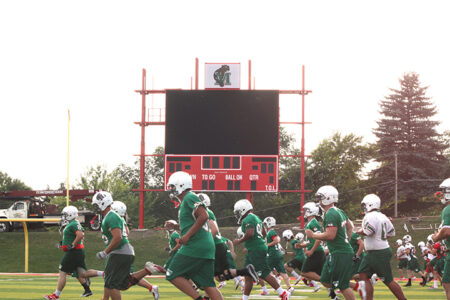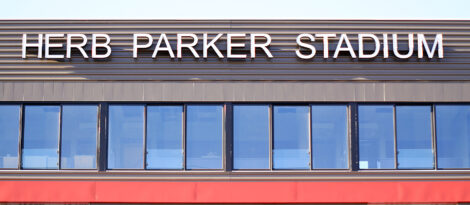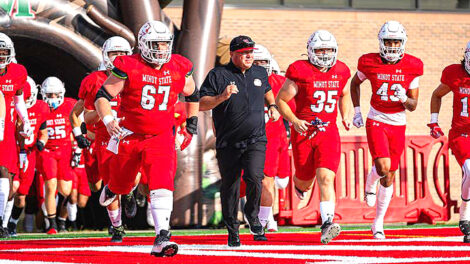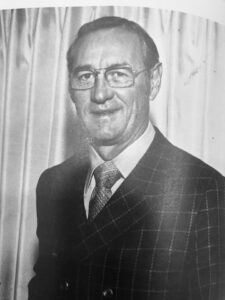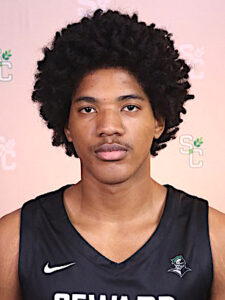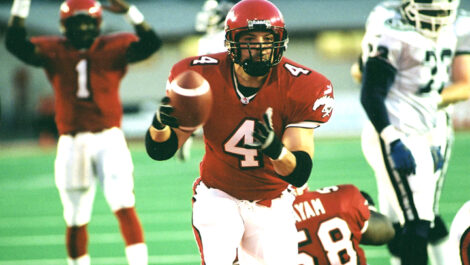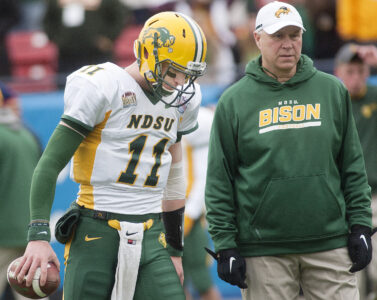Stadium renovation project was labor of love, put MSU on map

Herb Parker Stadium underwent a major three-phrase renovation project beginning in 2010 and was officially completed in 2015. Years later, a seasonal air-supported dome was constructed, used each year during the winter months.
When current Minot State University vice president for advancement and former sports information director Rick Hedberg takes a stroll around Herb Parker Stadium, he can’t help but crack a smile with what he sees looking back at him.
The artificial turf. The lights. The video scoreboard. The seats. The two-story press box. The berm. All of it was a labor of love that was well worth the time, effort and money to help usher in a new era of athletics at Minot State.
“It was an exciting time,” Hedberg said. “Anytime you can improve the facilities and make some major changes, that’s exciting. We had a president of the university that was very supportive and a lot of people stepped forward to help. Dr. (David) Fuller was the president at the time when we were looking at making these changes and improvements and you have to give him a lot of credit for supporting that.”
The start of the three-phase renovation project officially broke ground in 2010, 85 years after the program’s inaugural game against Bottineau School of Forestry, played on a field located elsewhere on campus. The Beavers would play on a permanent field two years later before moving to its current location in 1964. The old field is now the site of the Gordon B. Olson Library.
The new field would eventually don the name of Minot State’s legendary multisport coach and athletic director Herb Parker in 1983 following the announcement of his retirement. But outside of the name change, the stadium remained mostly unchanged for decades. That’s until the intrigue of Division II athletics pushed Minot State toward the modern era of home field advantage.

Herb Parker Stadium underwent a major three-phrase renovation project beginning in 2010 and was officially completed in 2015. Years later, a seasonal air-supported dome was constructed, used each year during the winter months.
The Beavers moved from the National Association of Intercollegiate Athletics (NAIA) to Division II as an independent in 2011 before officially joining the Northern Sun Intercollegiate Conference (NSIC) the following year. However, Hedberg knew that the only way they were going to be competitive at the next level was to vastly improve the state of their facilities. The NSIC also required Minot State to add a women’s soccer program, meaning the stadium would now have multiple tenets.
The planning stages started years before Minot State ever received a formal invite to join the NSIC, but the athletic department made sure to do exhaustive research before drawing up the blueprints to what their new stadium would look like.
“Part of our move to Division II was Dr. Fuller and I toured every campus in the Northern Sun during our application process with the Northern Sun Conference,” Hedberg said. “We went to every school – there were 14 at the time – except for two. It took us a couple weeks to do that over two or three trips, and we toured stadiums out of other schools and we saw what we were up against and it gave us an idea of what we needed to do. Then we went out and worked with a local architecture firm to present our vision of what we wanted to do and they put that together.”
The renovation process wasn’t always smooth sailing and Hedberg said the initial blueprints didn’t 100 percent match the final product, but that is par for the course for just about any project. The biggest hurdle was trying to keep the project within budget when it came to the press box. Initially, the press box was going to be approximately 16,000 square feet with 10 suites, but ended up being 10,750 square feet with 11 suites.
“We actually had to bid the project three times because of our budget,” Hedberg said. “As far as the stadium goes, we just had the press box piece and $4 million to work with at that time for the press box and suites and such. I just remember having to bid that three times because it just came in overbid. There were a lot of changes. Initially, we didn’t want to have suites on the lowest level just because of sight lines for suite holders, but we made some alterations to the plans and made it work. The final product didn’t resemble the very first renderings, but it turned out really nice.”
Part of the reason for the multiple rebids was the 2011 Souris River flood, which took place during the second phase of the project. The flood not only caused significant damage to the surrounding area, but it greatly increased the costs of materials and made it extremely difficult to find contractors who weren’t already working around the clock. During that time, Hedberg was in the midst of locking down material prices for the press box. Eventually, everything was situated and the necessary approvals were in place. The cost of the project had doubled to $8 million, but everybody saw the benefits in moving forward with the renovations. The funding came from the university, the Minot Community Facility Fund and private sponsorship.
“We did receive some support on the project from the city and there was a lot of issues going on in the city too, but overall just seeing the long term and what it could do for our city and our school really shown through, so we’re excited to see that,” Hedberg said.
The flooding did cause a small two-to-three week delay in the project timeline, time that was able to be made up. Phase 1 had been completed a year earlier and included the installation of FieldTurf, new lighting and berming the perimeter of the stadium. Phase 2 was completed the following year and included removing the old bleachers in favor of new bleachers as well as a section of chair-back club seats. The stadium expanded its capacity by 1,200 and can now hold more than 4,000 spectators. Also part of Phase 2 was the installation of a video replay scoreboard on the west berm, with Daktronics serving as the designer and installer. The scoreboard features a 14×25 foot LED video display, allowing the university to run live video as well as instant replay and advertising.
Phase 3 was the final piece of the project and included building the press box and suites. It broke ground on June 10, 2013, and the grand opening took place nearly two years later on May 2, 2015. EPAC Architects Engineers, a design firm originating out of Grand Forks, served as the architect for the press box. The stadium went a few seasons without a press box, as the old building was torn down in 2012.
Minot State held a ribbon cutting ceremony to commemorate the historical occasion leading up to the annual spring football game later in the day. MSU President Dr. Steven Shirley, along with Minot Mayor Chuck Barney, Hedberg and members of the Parker family were in attendance. The university held free youth football and soccer clinics for kids from kindergarten through eighth grade.
More than just the local community has taken notice of the facilities that Minot State now has to offer.
“We’ve been able to keep pace pretty much with the rest of the conference,” Hedberg said. “We’re on the perimeter of our league and a lot of the people we play have never been to Minot and once they get here and see what we have, it’s impressive to them. I think bringing people in as far as recruiting visits, it’s definitely a positive for our campus. Our coaches will tell you that to have those facilities we need to continue to keep moving forward because many of the other schools are moving forward. It’s a challenge, but it’s one we’re going to keep working for.”
Always looking for opportunities to continue to improve the facilities at Minot State, Hedberg went right back to work immediately following the completion of what was nearly a 10-year project from the planning stages to the ribbon cutting ceremony. Just over a year later, construction began on a seasonal air-supported multisport dome that would span the length of the football field and be used from November to late April or early May. The bubble cost approximately $2 million, with $1 million paid for from the city of Minot’s Community Facilities Fund grant and another $1 raised by the university from private individuals, foundations and local businesses.
Construction started in August of 2016 and installation began in December of 2017, with the public getting their first glimpse of the 86,000 square-feet structure with a max height of 70 feet in January of 2018. The installation was completed by Yeadon Fabric Domes.
“Those two things between the turf and the bubble and being able to utilize that facility year-round I think probably brings the biggest satisfaction,” Hedberg said. “Not just football and soccer, but we train in there all winter long. Softball is playing games in there in February and March and all of our teams are training all winter. That’s really satisfying and using it as a golf driving range and bringing other community members in and hosting other events, whether it be the state soccer cup in January when it’s -20 outside and there are 100 indoor soccer teams playing in a tournament, that’s pretty satisfying.”
Hedberg said that the university has had several schools and organizations reach out since the completion of all of its renovations. The Minot Air Force base recently installed its own bubble and both Bismarck and Dickinson have had talks about the air-supported dome. Fellow NSIC member Northern State took a visit to the Minot State campus years back and have since made improvements to their stadium.
Minot State replaced the FieldTurf playing surface in 2022 in what was the final renovation to the stadium to date, also agreeing to a 10-year naming rights agreement with First Western Bank. The stadium has since gone by the official name of First Western Bank Field at Herb Parker Stadium. Hedberg said the typical lifespan of artificial turf is between 10-12 years and it had been 11 years at the time of replacement. The new field provides for better technology and costs about $600,000 to install. Since the understructure didn’t need to be replaced along with the playing surface, the project cost about 50 percent less.
As for what’s next, Hedberg said the university is shifting its attention away from the football stadium and more toward the MSU Dome and other athletic facilities, looking to upgrade locker rooms among other projects. They recently made improvements to the weight room and the nutrition center.
“Overall, it’s been a really great addition and we’re going to keep moving forward with ideas and expansions and I’m excited for potential changes down the road,” Hedberg said.
- Herb Parker Stadium underwent a major three-phrase renovation project beginning in 2010 and was officially completed in 2015. Years later, a seasonal air-supported dome was constructed, used each year during the winter months.
- Herb Parker Stadium underwent a major three-phrase renovation project beginning in 2010 and was officially completed in 2015. Years later, a seasonal air-supported dome was constructed, used each year during the winter months.

